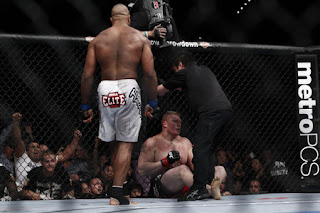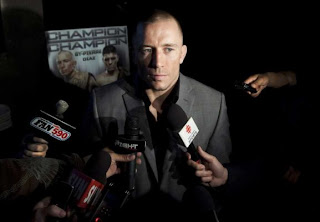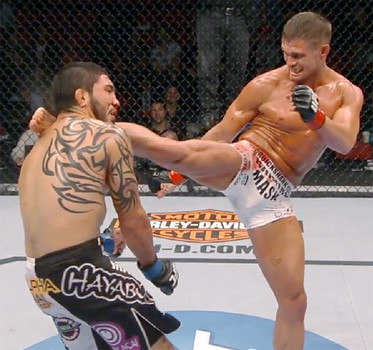With Brock Lesnar retired, and GSP gone for most, if not all, of 2012, the UFC goes into its bona fide network TV debut short on stars. Here’s a five-step plan to make more.
First off, let me be clear: There will never be another Brock Lesnar. He came along at the right moment, with the right background, the right look, and the right attitude, one that fit the zeitgeist of the media and casual fan’s perception of the sport of mixed martial arts, specifically, the UFC. Now that the moment is past, and the UFC is positioned firmly in the mainstream sports landscape, the next big star will need to be of this time, and with the requisite background, look, attitude, and “hook” that the media and casual fan can take to. Much has been said about the profound effect that the loss of Lesnar and GSP will have on the UFC’s bottom line, and the company’s “need to build stars” is fast-becoming the storyline to watch in 2012, but shouting it to the heavens won’t make it so. No, what is necessary is a complete reorientation of the UFC’s core product, and a reimagining of what it means to be a “star.”
 Contrary to popular belief, sports leagues and teams don’t make stars; the media does. Teams and leagues can try to make someone the “face” of a franchise/sport, but without the mechanism of giving that “face” the requisite amount of exposure, coverage, and accolades, their attempts fall flat. Furthermore, the athletes themselves need to put on transcendent performances in the face of that scrutiny and spotlight. Yes, it’s possible to gain a cult following through simply being quirky and desperate for attention, but to be a star, the attention you command must eventually be earned through your performances on the field of play.
Contrary to popular belief, sports leagues and teams don’t make stars; the media does. Teams and leagues can try to make someone the “face” of a franchise/sport, but without the mechanism of giving that “face” the requisite amount of exposure, coverage, and accolades, their attempts fall flat. Furthermore, the athletes themselves need to put on transcendent performances in the face of that scrutiny and spotlight. Yes, it’s possible to gain a cult following through simply being quirky and desperate for attention, but to be a star, the attention you command must eventually be earned through your performances on the field of play.
The UFC currently has seven world champions, and only one can truly be called a star — Georges St. Pierre. And his stardom is the result of the careful cultivation of his out-of-cage persona, in tandem with his establishment of dominance inside of the Octagon. But the UFC wasn’t behind GSP’s savvy image management, Shari Spencer was. He was positioned as a young, classy, somewhat soft-spoken professional, equal parts martial artist and sportsman, a French-Canadian who considered himself a representative of the entire country. For a sport which was filled with brash, anti-social, alpha males, and embraced that ethos, GSP stood in stark contrast, a fighter who your mother would like, and an athlete whose discipline and work ethic rivaled that of any other well-regarded superstar athlete, no matter the sport.
But like Brock, GSP’s ascension too was a product of the moment. Now that GSP has blazed the trail, the next generation of UFC star has to fit with what 2012 and the modern landscape requires:
 1. Accessible – Yes, today we expect our stars to be larger than life, and while it is refreshing that MMA fighters are down to earth, that “everyman” nature is actually an impediment to stardom. Fans are investing emotionally in the success of a fighter, and paying money to see him win or lose; he actually needs to be striving for something special, and have proven himself capable of achieving it. Yet even while acknowledging the special-ness of a fighter’s physical gifts or honed skill set, his “story” should be accessible. Brock Lesnar’s “pro wrestler trying his hand at real fighting,” or Kimbo Slice’s “backyard brawler fighting professional fighters,” is an easily-digestible way to think of what those fighters stand for, and although their stories are more complex, to casual viewers, it’s more than enough.
1. Accessible – Yes, today we expect our stars to be larger than life, and while it is refreshing that MMA fighters are down to earth, that “everyman” nature is actually an impediment to stardom. Fans are investing emotionally in the success of a fighter, and paying money to see him win or lose; he actually needs to be striving for something special, and have proven himself capable of achieving it. Yet even while acknowledging the special-ness of a fighter’s physical gifts or honed skill set, his “story” should be accessible. Brock Lesnar’s “pro wrestler trying his hand at real fighting,” or Kimbo Slice’s “backyard brawler fighting professional fighters,” is an easily-digestible way to think of what those fighters stand for, and although their stories are more complex, to casual viewers, it’s more than enough.
 2. World Class – Now that the UFC is the premier mixed martial arts organization in the world, fighters from every quarter are expected to be represented there. Obviously Americans love seeing other Americans succeed, but when any athlete represents an entire nation, casual fans appreciate that nationalistic component as an additional reason to pay attention to that athlete. The enthusiasm that one community has for a particular fighter can be infectious, and when that fighter handles the additional support with poise and grace, it can be an inclusive thing that fans who aren’t part of that community can partake in. When he does not, however, the dark side of that nationalistic fervor emerges, and tribalism abounds. Some of the most heated feuds in sports history have been the result of clashes between ethnicities and nationalities which come to a head when representatives of those groups do battle on the field or in the squared circle. And when a fighter embodies aspirations of national greatness on the world stage, he is imbued with a little something extra.
2. World Class – Now that the UFC is the premier mixed martial arts organization in the world, fighters from every quarter are expected to be represented there. Obviously Americans love seeing other Americans succeed, but when any athlete represents an entire nation, casual fans appreciate that nationalistic component as an additional reason to pay attention to that athlete. The enthusiasm that one community has for a particular fighter can be infectious, and when that fighter handles the additional support with poise and grace, it can be an inclusive thing that fans who aren’t part of that community can partake in. When he does not, however, the dark side of that nationalistic fervor emerges, and tribalism abounds. Some of the most heated feuds in sports history have been the result of clashes between ethnicities and nationalities which come to a head when representatives of those groups do battle on the field or in the squared circle. And when a fighter embodies aspirations of national greatness on the world stage, he is imbued with a little something extra.
 3. Photogenic – This doesn’t mean “good-looking,” although being handsome doesn’t hurt. It means having a distinctive appearance, one which registers with people upon first or second impression, and standing out from the crowd. Wanderlei Silva in his heyday is an example of someone we wouldn’t consider handsome, but whose striking appearance made us pay attention. If you can get a casual fan or a first-time viewer to raise an eyebrow, you’re part of the way there, in terms of becoming a star. Conversely, one of the worst things you want to have happen if you’re trying to be a star is to be easily confused with another person…especially if that person is not a star.
3. Photogenic – This doesn’t mean “good-looking,” although being handsome doesn’t hurt. It means having a distinctive appearance, one which registers with people upon first or second impression, and standing out from the crowd. Wanderlei Silva in his heyday is an example of someone we wouldn’t consider handsome, but whose striking appearance made us pay attention. If you can get a casual fan or a first-time viewer to raise an eyebrow, you’re part of the way there, in terms of becoming a star. Conversely, one of the worst things you want to have happen if you’re trying to be a star is to be easily confused with another person…especially if that person is not a star.
 4. Athletic – This goes without saying, but MMA is a sport now. It was a sport before, but the element of spectacle or “freakshow” was there enough to undercut the idea that the goal was athletic competition. Whether bloodsport or toughman competition or curiosity, the baggage of the old UFC endures, and new stars need to be mindful that the sport’s past hinders its accessibility to current and future fans. That’s why it’s so important that the UFC, the highest level of the sport, be populated with athletes. This is not to say that everyone should be able to dunk a basketball, or run a 4.3 40 yard dash, or have rippling muscles and washboard abs. However, they should be physically fit, and even though their impressive feats may be born out of toughness, they should also be equally attributable to athleticism. In fact, the term “deceptively athletic” is very often reserved for people who don’t look physically fit, yet succeed in a particular sport. And if it’s a necessary qualifier in mainstream sports, you had best believe that any casual fan who encounters a fighter with the dimensions of a Roy Nelson expects to have his initial impression allayed by evidence that that fighter possesses deceptive athleticism.
4. Athletic – This goes without saying, but MMA is a sport now. It was a sport before, but the element of spectacle or “freakshow” was there enough to undercut the idea that the goal was athletic competition. Whether bloodsport or toughman competition or curiosity, the baggage of the old UFC endures, and new stars need to be mindful that the sport’s past hinders its accessibility to current and future fans. That’s why it’s so important that the UFC, the highest level of the sport, be populated with athletes. This is not to say that everyone should be able to dunk a basketball, or run a 4.3 40 yard dash, or have rippling muscles and washboard abs. However, they should be physically fit, and even though their impressive feats may be born out of toughness, they should also be equally attributable to athleticism. In fact, the term “deceptively athletic” is very often reserved for people who don’t look physically fit, yet succeed in a particular sport. And if it’s a necessary qualifier in mainstream sports, you had best believe that any casual fan who encounters a fighter with the dimensions of a Roy Nelson expects to have his initial impression allayed by evidence that that fighter possesses deceptive athleticism.
 5. Compelling – This isn’t as simple as being “exciting.” Something about this fighter should engage the imagination. Yes, that could be an exciting fighting style, an ability to finish fights (or be finished) at any moment, but it can also be a flair for drama, a visual intensity, or a body language that continues to tell a story as the fight progresses. Furthermore, an expressive personality outside the cage, or in interviews, can color the way fans perceive athletic performances. The boxer Floyd “Money” Mayweather has crafted a particularly outgoing personality outside of the ring, and as such, his virtuoso performances of technical acumen, while awe-inspiring, end up serving as the prelude to the real main event, his post-fight interview, where he congratulates his greatness, and verbally spars with any commentator who would have us believe otherwise. Whether or not a lot ultimately happens in the fight actionwise, what does happen is more meaningful, because of the way he goes about his business, and what that means to fans.
5. Compelling – This isn’t as simple as being “exciting.” Something about this fighter should engage the imagination. Yes, that could be an exciting fighting style, an ability to finish fights (or be finished) at any moment, but it can also be a flair for drama, a visual intensity, or a body language that continues to tell a story as the fight progresses. Furthermore, an expressive personality outside the cage, or in interviews, can color the way fans perceive athletic performances. The boxer Floyd “Money” Mayweather has crafted a particularly outgoing personality outside of the ring, and as such, his virtuoso performances of technical acumen, while awe-inspiring, end up serving as the prelude to the real main event, his post-fight interview, where he congratulates his greatness, and verbally spars with any commentator who would have us believe otherwise. Whether or not a lot ultimately happens in the fight actionwise, what does happen is more meaningful, because of the way he goes about his business, and what that means to fans.
In assessing whether an up-and-coming UFC fighter can achieve stardom, we should consider these components as necessary factors in the analysis. The UFC will try to make as many stars as it can, but few will possess these characteristics, and the ones that do, that “move the needle” with the media, will be positioned for stardom. Of course, possessing these qualities is only part of the equation. Other factors have to fall into place, and the spotlight needs to shine brightly before a star-making performance can truly be put on. Stars are neither completely born nor completely made; they are products of chance, of process, of opportunity, and of excellence. The next piece in the series will expound upon the mechanisms by which stardom in the UFC can be attained under the current system.




